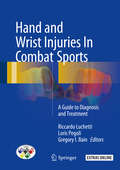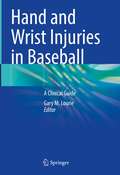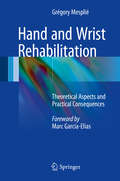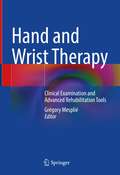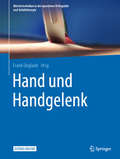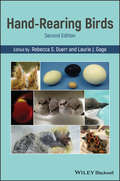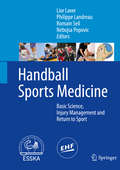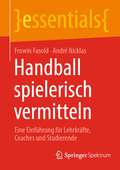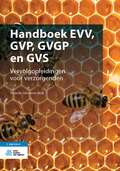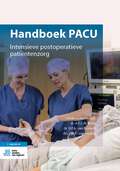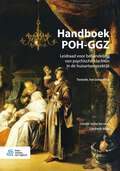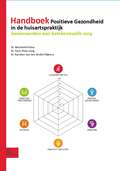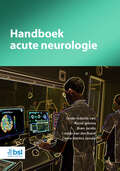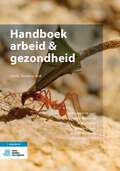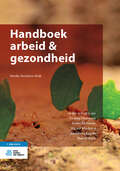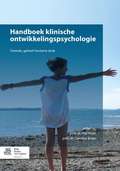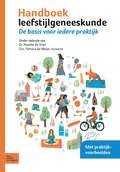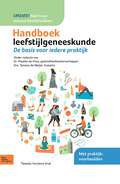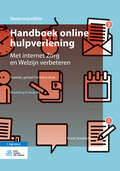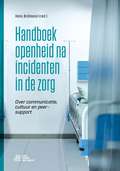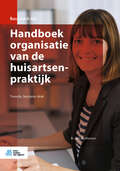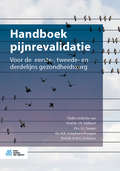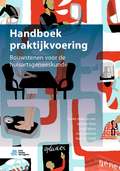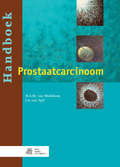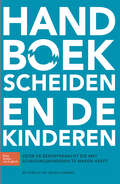- Table View
- List View
Hand and Wrist Injuries In Combat Sports: A Guide to Diagnosis and Treatment
by Riccardo Luchetti Gregory I. Bain Loris PegoliThis well-illustrated book describes the injuries to the hand and wrist that are commonly encountered among participants in combat sports, explaining the mechanisms of injury and offering state of the art guidance on diagnosis and treatment. It covers both injuries characteristic of individual sports, such as kendo, karate, judo, jiu-jitsu, aikido, and mixed martial arts, and pathologies encountered across the full range of combat sports, including boxing, wrestling, and taekwondo. In addition to management, careful attention is paid to rehabilitation following injury and to psychological aspects of recovery from injury. The book is the result of a collaboration with the International Society for Sport Traumatology of the Hand (ISSPORTH) and has been designed to meet the needs of all practitioners who work with combat sports athletes. While especially helpful for surgeons, physicians, therapists, and rehabilitators, it will also be of value to coaches, trainers, and players. The authors are leading international experts in the field who have been involved with international societies and in some cases have personal experience of combat sports at a high level.
Hand and Wrist Injuries in Baseball: A Clinical Guide
by Gary M. LourieThis book comprehensively reviews soft tissue, bone, ligament, and nerve injury of the hand and wrist unique to baseball. Organized into three sections, the book begins with a discussion on fractures of the hand and wrist, including the distal radius, scaphoid, and phalanges. Following this, section two examines ligament injuries from the wrist to the thumb. Section three then concludes the book with an analysis of tendon and nerve injuries. Chapters include high-quality images and tables to supplement expertly written text.Unique and thorough, Hand and Wrist Injuries in Baseball is an invaluable resource for orthopedics surgeons and sports medicine specialists, as well as primary care physicians, emergency room physicians, pediatricians, athletic trainers, and therapists.
Hand and Wrist Rehabilitation
by Grégory MespliéThis work demonstrates that hand and wrist rehabilitation calls for precise anatomical, biomechanical, and physiological expertise, as well as mastery of manual techniques and targeted physiotherapy. Particular attention is given to the complementarity between theoretical knowledge and practical aspects; accordingly, refreshers on the underlying theory; descriptions of the rehabilitation protocols and the specific manual and instrumental techniques; and the type of orthesis used depending on the delay of healing are provided for each pathology. This publication will appeal to a broad readership, from physiotherapists and occupational therapists, to surgeons and practitioners specialized in physical rehabilitation, to students in the fields of physiotherapy and occupational therapy.
Hand and Wrist Therapy: Clinical Examination and Advanced Rehabilitation Tools
by Grégory MespliéThis book developed from the experience of the ISAMMS team (Institut Sud Aquitain de la Main et du Membre Supérieur), that has been treating hand and wrist pathologies for over 20 years. Hand and wrist require specific care from a multidisciplinary staff. The patient has to be treated efficiently from injury in order to be able to return to work and sports activities. The book presents the most validated clinical examination, clinical reasoning, rehabilitation techniques and orthoses allowing the therapist to maximize their efficiency in treating patients with hand and wrist pathologies. This publication is intended for physiotherapists and occupational therapists, surgeons and practitioners specialized in physical rehabilitation, as well as for the students in these fields.
Hand und Handgelenk (Meistertechniken in der operativen Orthopädie und Unfallchirurgie)
by Frank UnglaubDie Buchreihe „Meistertechniken in der operativen Orthopädie und Unfallchirurgie“ erlaubt es dem operativ tätigen Orthopäden und Unfallchirurgen, den Autoren - alle sind Meister ihres Faches - beim Operieren direkt über die Schulter zu schauen. Beschrieben werden häufige, aber erfahrungsgemäß schwierige Probleme und Techniken so, dass der erfahrene, aber im jeweiligen Gebiet nicht hochspezialisierte Operateur den jeweiligen Eingriff mit höherer Sicherheit auszuführen vermag. Alle Beschreibungen lassen sich direkt in die Praxis umsetzen: die Operationsverfahren werden step-by-step dargestellt und mit zahlreichen Fotos und brillanten Grafiken visualisiert. Initiiert und begleitet wird die Reihe durch Prof. Dr. med. D. Kohn und Prof. Dr. med. T. Pohlemann. Der vorliegende 3. Band "Hand und Handgelenk" wurde von Prof. Dr. med. Frank Unglaub herausgegeben.
Hand-Rearing Birds
by Laurie J. Gage Rebecca S. DuerrThis book presents a detailed guide to hand-rearing techniques for raising young birds, providing complete coverage of a wide variety of avian species and taxonomic groups for all avian care professionals. Chapters are written by expert rehabilitation, aviculture, and zoo professionals, and include useful references and bibliographies for further reading and research. Each chapter provides valuable information on appropriate intervention, housing, feeding, and care. Hand-Rearing Birds, Second Edition presents 50 chapters, including 12 new chapters on species or groups of species not featured in the previous edition. It also features color photographs that help illustrate many concepts pertinent to birds. This important reference: Offers a detailed guide to hand-rearing techniques including species-specific guides to caring for and raising young birds Covers a wide variety of avian species and taxonomic groups Discusses how to examine a chick to identify problems such as hypothermia, dehydration, injuries, and common diseases, and what to do Combines information on the science and skill needed to successfully hand-rear birds Presents full-color photographs throughout Hand-Rearing Birds, Second Edition is an essential resource for avian rehabilitators, breeders, veterinarians, and zoo staff.
Handball Sports Medicine: Basic Science, Injury Management And Return To Sport
by Romain Seil Lior Laver Philippe Landreau Nebojsa PopovicThis book is designed to help improve the medical care of athletes across the world who play team handball – including not only handball itself but also such sports as beach volleyball and mini-handball. It provides concise practical information on the nature of frequently encountered injuries, the management of these injuries, injury prevention, and rehabilitation following treatment. Individual sections also focus on physiologic, endocrinologic, biomechanical, and nutritional aspects; special considerations in particular groups of players; and psychological issues. The medical needs of a handball team are explained, and guidance offered on preparticipation assessment and screening. All of the authors are leaders in their field. Their excellent teamwork ensures that the book, published in collaboration with ESSKA, will represent a superb, comprehensive educational resource. It will meet the needs of both handball medical caregivers and handball personnel, providing readily accessible answers to a wide range of medical questions and facilitating effective collaboration among the various professionals involved in team handball.
Handball spielerisch vermitteln: Eine Einführung für Lehrkräfte, Coaches und Studierende (essentials)
by Frowin Fasold André NicklasDie Ursprünge des Sportspiels Handball lassen sich auf den Beginn des 20. Jahrhunderts datieren. Das Spiel hat sich seitdem stetig weiterentwickelt und findet sich heutzutage in vielfältigen Ausprägungen wieder. In der hier vorgeschlagenen Vermittlungskonzeptionen sollen die Grundlagen des Sportspiels Handball dargelegt werden. Eine universell anwendbare Spielreihe soll eine Vermittlung des Spiels im Grundlagenbereich für Lehrkräfte, Coaches und Studierende ermöglichen. Weitergehend werden die Grundlagen zu technisch-taktischen Elementen erläutert, welche in der Vermittlung einer handballspezifischen Spielfähigkeit hilfreich sein können. Hinweise zum Coaching und zu Spielleiter-Tätigkeiten schließen diese Konzeption ab.
Handboek EVV, GVP, GVGP en GVS: Vervolgopleidingen voor verzorgenden
by Nicolien van HalemDit handboek is een compleet en onmisbaar naslagwerk voor verzorgenden die (gaan) werken als eerstverantwoordelijk verzorgende (EVV), contactverzorgende, zorgcoördinator, gespecialiseerd verzorgende psychogeriatrie (GVP) of gespecialiseerd verzorgende gerontopsychiatrie (GVGP) en gespecialiseerd verzorgende somatiek (GVS). Het boek is gericht op alle sectoren in de VVT. Handboek EVV, GVP, GVGP en GVS is een herziene versie van Handboek EVV en GVP. In deze versie is de inhoud aangepast aan de geactualiseerde opleidingseisen van het College Zorg Opleidingen (CZO). Bovendien zijn de GVGP en GVS opleidingen nu meegenomen. Handboek EVV, GVP, GVGP en GVS biedt een stevige theoretische basis. Het bespreekt eerst het vakinhoudelijk handelen: methodisch werken en ziektebeelden. Vervolgens vertaalt het de zeven CanMEDSrollen naar de praktijk van de gespecialiseerd verzorgende. Het gaat in op communicatie, samenwerken, reflecteren en maatschappelijk handelen. De EVV wordt steeds gebruikt als basis voor de andere specialisaties. Zo sluit het boek aan bij de rangschikking van het CZO. Tegelijkertijd beslaat het de eindtermen van de drie specialisaties, waardoor deelnemers van vier opleidingen dit handboek kunnen gebruiken. Zoals werkbijen bouwen aan nieuwe honingraten, zo kunnen verzorgenden bouwen aan nieuwe specialisaties.
Handboek PACU: Intensieve postoperatieve patiëntenzorg
by H.P.A. van Dongen A.F.J. de Bruin J.M.K. van FessemDit boek vormt een leidraad hoe te handelen bij veel voorkomende problemen op een Post Anesthesia Care Unit (PACU). Het doel is een bijdrage te leveren aan het standaardiseren van de zorg op een PACU en de postoperatieve morbiditeit en mortaliteit na hoog-risico chirurgie bij hoog-risico patiënten te verlagen.Op een PACU vindt postoperatieve zorg plaats voor patiënten die na een operatie intensieve monitoring nodig hebben tot maximaal de ochtend van de tweede postoperatieve dag, alvorens de patiënt naar de reguliere afdeling wordt overgeplaatst. De postoperatieve PACU-opnameperiode is veelal voldoende om de vitale functies van de patiënt die peroperatief bedreigd zijn geraakt adequaat te stabiliseren. PACU is een belangrijk onderdeel van het ‘enhanced recovery after surgery’ programma (ERAS). Vroege complicaties worden eerder herkend en late complicaties worden voorkomen op een PACU. De diversiteit aan patiënten vereist een multidisciplinaire expertise en behandeling. Effectieve samenwerking leidt tot betere postoperatieve uitkomsten. Het auteursteam weerspiegelt dan ook de multidisciplinaire c.q. interprofessionele samenwerking. Handboek PACU is mede mogelijk gemaakt door de Nederlandse Vereniging voor Anesthesiologie (NVA) en is geschreven voor en door verpleegkundigen, verpleegkundig specialisten, anesthesiologen, chirurgen en andere medisch specialisten.
Handboek POH-GGZ: Leidraad voor behandeling van psychische klachten in de huisartsenpraktijk
by Liesbeth MokDit boek biedt een leidraad voor de dagelijkse werkzaamheden van de POH-GGZ. Deze herziene versie van het Handboek POH-GGZ is geactualiseerd, verdiept en uitgebreid. Het biedt een overzicht van de belangrijke thema’s en patiëntgroepen die de generalistische POH-GGZ ziet. Zo is er aandacht voor aanpassingsklachten, angst- en stemmingsklachten, overspanning/burn-out en chronisch psychiatrische problematiek. Modellen uit het methodisch referentiekader, zoals cognitieve gedragstherapie, positieve psychologie en het KOP-model worden beschreven, evenals de voorwaarden waaraan correcte dossiervoering dient te voldoen. Naast extra aandacht voor jeugd en jongeren is er een nieuw hoofdstuk over ouderen. Nieuw zijn ook o.a. ALK, geboortezorg, schematherapie en gender- en seksespecifieke zorg. Ook is er aandacht voor niet-patiëntgebonden taken zoals die noodzakelijk zijn voor positionering en deskundigheidsbevordering. Het boek nodigt uit tot reflectie over inhoud van de werkzaamheden en inspireert tot nascholing. Met de praktische handreikingen kan de POH-GGZ volwaardige psychologische zorg in de huisartsenpraktijk bieden. Deze uitgave is bedoeld voor de professional die werkzaam is als POH-GGZ of hiermee samenwerkt, zoals de huisarts, psychosomatisch fysiotherapeut, POH, wijkverpleegkundige, apotheker-farmacotherapeut, psycholoog, psychiater en de beroepskrachten uit het wijkteam. De auteurs werken als POH-GGZ en huisarts. Zij ervaren zelf het belang van samenwerking om goede patiëntenzorg te bieden. Daarnaast zijn er bijdragen geleverd door deskundigen met specifieke kennis die van belang zijn voor huisartsenzorg.
Handboek Positieve Gezondheid in de huisartspraktijk: Samenwerken aan betekenisvolle zorg
by Machteld Huber Hans Peter Jung Karolien van den Brekel-DijkstraSteeds meer huisartsen ervaren dat werken met Positieve Gezondheid veel oplevert. Het helpt om een ander gesprek te voeren met de patiënt. De focus ligt niet op ziekte, maar op wat er wél kan. Dat is prettig voor de patiënt. En ook voor de huisarts. Maar hoe zetten we Positieve Gezondheid in? Daar biedt dit handboek nuttige handvatten voor!Dit boek zit boordevol tips, vertelt de ontstaansgeschiedenis en geeft praktijkvoorbeelden. Het neemt je mee in het gedachtegoed van Positieve Gezondheid - dat nadrukkelijk oog heeft voor wat betekenisvol is voor de patiënt. Maar bovenal nodigt dit boek je uit om met Positieve Gezondheid aan de slag te gaan in de spreekkamer, in de praktijkorganisatie en in de wijk. Want juist in samenhang zit de kracht. In al die onderdelen ervaar je hoe Positieve Gezondheid naadloos aansluit bij de kernwaarden en uitdagingen van de huisartsgeneeskunde.Het handboek is bedoeld voor professionals in de huisartspraktijk – en voor wie daarvoor in opleiding is. Tal van huisartsen hebben meegedacht over wat zij in dit boek willen terugvinden. De uitgave is dan ook onmisbaar voor wie met Positieve Gezondheid betekenisvolle huisartsenzorg wil bieden.Over de auteursMachteld Huber is voormalig huisarts en grondlegger van Positieve Gezondheid. Huisartsen Hans Peter Jung en Karolien van den Brekel-Dijkstra werken dagelijks met het gedachtegoed in de praktijk. Alle drie zijn ze verbonden aan het Institute for Positive Health. “Positieve Gezondheid is een stimulerende werkwijze om de problemen van patiënten in de huidige tijd te tackelen.” – Ella Kalsbeek
Handboek acute neurologie
by Korné Jellema Bram Jacobs Crispijn van den Brand Carine Martins JarnaloDit boek biedt een actueel overzicht van de diagnostiek en behandeling van patiënten met acute neurologische problematiek. Het geeft een volledig overzicht van acute neurologische aandoeningen en voorziet in een belangrijke behoefte deze kennis te bundelen in één handzaam boek. De acute neurologie maakt razendsnelle ontwikkelingen door. De vooruitgang op het gebied van de vasculaire neurologie is hierin het meest aansprekend. Tot nu toe ontbrak het aan een Nederlandstalig boek. Het Handboek acute neurologie vult deze leemte. Het boek is opgedeeld in twee delen: Deel 1 behandelt de meest voorkomende ingangsklachten. Deel 2 gaat in op de veelvoorkomende ziektebeelden op de spoedeisende hulp (SEH). Het handboek is rijk geïllustreerd met afbeeldingen van radiologische onderzoeken en verhelderende tekeningen. Dankzij overzichtelijke tabellen en stroomdiagrammen vindt de lezer snel de juiste informatie. Het Handboek acute neurologie is bedoeld voor alle medische professionals die in aanraking komen met patiënten met een acute neurologische klacht, zoals SEH-artsen, neurologen en huisartsen, arts-assistenten, PA`s en verpleegkundig specialisten die werkzaamheden verrichten op de SEH en voor SEH- en ambulanceverpleegkundigen. De redacteurs en auteurs zijn werkzaam in diverse Nederlandse ziekenhuizen en universitaire medische centra en hebben uitgebreide ervaring op het gebied van de acute neurologie, zowel vakinhoudelijk als wetenschappelijk en onderwijskundig.
Handboek arbeid & gezondheid
by Yvonne Heerkens André Bieleman Harald Miedema Josephine Engels Marcel BalmDit boek helpt professionals om de meest optimale ondersteuning te bieden aan mensen die (weer) aan het werk gaan, of aan het werk willen blijven. Het is met name bedoeld voor zorg-, arbo-, en HR-professionals.In Handboek arbeid & gezondheid staat de relatie tussen arbeid en gezondheid centraal. Daarbij wordt gezondheid breed opgevat – vanuit een holistische visie. Het boek beschrijft arbeidsparticipatie vanuit verschillende perspectieven, en legt uit hoe daarmee om te gaan. Bijvoorbeeld in relatie tot de steeds ouder wordende doelgroep van werkenden, op mensen met chronische aandoeningen, en de speciale situatie van ZZP’ers. Thema’s als wet- en regelgeving, duurzame inzetbaarheid en multidisciplinaire samenwerking komen daarbij ook aan de orde. Daarnaast beschrijft Handboek arbeid & gezondheid wat er nodig is om de organisatie waar het werk plaatsvindt ‘gezond’ te houden. Het beschrijft bijvoorbeeld gedrags- en cultuurveranderingen en aandacht voor een gezonde en veilige werkomgeving. Deze vierde editie van het Handboek arbeid & gezondheid is geheel geactualiseerd. Het sluit naadloos aan bij de recente ontwikkelingen in werk en gezondheid, zoals de gevolgen van de COVID-19-pandemie.
Handboek arbeid & gezondheid: Een Handboek Voor Paramedici En Arboprofessionals
by Yvonne Heerkens André Bieleman Harald Miedema Josephine Engels Marcel BalmDit boek geeft antwoord op de vraag hoe je integratie, inclusieve arbeid, duurzame inzetbaarheid en re-integratie bevordert. Werk is belangrijk voor mensen; werk draagt bij aan zelfstandigheid, zelfrespect en ontplooiing. En met de toenemende vergrijzing en flexibilisering van de arbeidsmarkt is het bevorderen van duurzame arbeidsparticipatie een steeds grotere uitdaging. Hoe pak je dat aan? Deze derde editie van het Handboek Arbeid & Gezondheid is geheel geactualiseerd. Daarnaast is de focus van het boek aangepast. Er is meer aandacht voor de verschillende perspectieven van waaruit je naar arbeidsparticipatie kunt kijken, de grote variëteit aan professionals die in de verschillende contexten van arbeid werkzaam zijn en de wijze waarop zij samenwerken. In het traject van het aan het werk krijgen (inclusie / integratie), aan het werk houden en het weer terugbrengen naar het werk (re-integratie) spelen – naast de werkende zelf - veel professionals een rol, waaronder paramedici, arbeidsdeskundigen, arboverpleegkundigen en toegepast psychologen. Zij vormen samen de doelgroep van dit handboek. Ook andere (arbo)professionals zijn betrokken, zoals bedrijfs- en verzekeringsartsen, HRM-managers en preventiemedewerkers. Het Handboek Arbeid & Gezondheid is onmisbaar voor iedereen in opleiding tot beroepen gericht op het bevorderen van duurzame arbeidsparticipatie. Ook voor alle professionals die al werken in het mooie maar complexe veld arbeid en gezondheid is dit boek een nuttige bron van informatie.
Handboek klinische ontwikkelingspsychologie
by prof. dr. Pier Prins prof. dr. Caroline BraetOngeveer 10 à 15% van de kinderen en jongeren ontwikkelt zich niet goed en vertoont problemen op uiteenlopende gebieden. Deze problemen herstellen zich vaak, maar bij een aantal kinderen gaan ze niet vanzelf over. Er ontwikkelt zich een stoornis, zoals een angst- of gedragsstoornis.Klinische ontwikkelingspsychologie houdt zich bezig met deze psychische problemen en stoornissen bij kinderen. Dit boek benadert de normale en afwijkende ontwikkeling vanuit het transactionele perspectief: wat is de rol van kind en omgeving en hoe beïnvloeden zij elkaar?In deze geheel herziene uitgave wordt ingegaan op de vraag wat bij ‘normale ontwikkeling’ past, wat ‘afwijkend’ is en welke mechanismen hierbij een rol spelen. Wanneer wijkt het functioneren significant af van wat bij de leeftijd hoort en wanneer belemmert het de verdere ontwikkeling? Thema’s die in dit boek aan de orde komen zijn: genetische kwetsbaarheid, pre- en perinatale ontwikkeling, de ontwikkeling van temperaments- en persoonlijkheidskenmerken, de rol van ouders en het gezin, de sociale relaties, en de cultuur. Daarnaast behandelen de auteurs veel voorkomende ontwikkelingsproblemen en emotionele en gedragsproblemen, zoals agressie en regelovertredend gedrag, aandachts- en impulsiviteitsproblemen, angst en stemmingsproblemen, pervasieve ontwikkelingsstoornissen, kindermishandeling en gehechtheidsproblemen, eetstoornissen, middelenmisbruik en verslaving. Ook de veranderingen rond de introductie van de DSM-5 worden besproken. Aan de hand van voorbeelden wordt een en ander naar de dagelijkse praktijk vertaald,waarbij wordt ingegaan op de betekenis voor diagnostiek en interventie. Het Handboek klinische ontwikkelingspsychologie staat onder redactie van prof. dr. Pier Prins en prof. dr. Caroline Braet.
Handboek leefstijlgeneeskunde: De basis voor iedere praktijk
by Maaike De Vries Tamara De WeijerDit boek geeft artsen (in opleiding), praktijkondersteuners en verpleegkundigen, apothekers, paramedici, ggz-medewerkers en andere professionals in en om de zorg een heel praktisch en actueel overzicht van de leefstijlgeneeskunde. Wat is het? Wat werkt en wat niet? En hoe kan ik het inzetten in mijn klinische praktijk, met en bij mijn patiënten? Tot voor kort werd leefstijl vooral gezien als een middel ter preventie van aandoeningen. In toenemende mate worden voeding, beweging, ontspanning, slaap, sociale contacten en zingeving ook succesvol ingezet bij de behandeling van chronische aandoeningen. In dit boek presenteren vooraanstaande hoogleraren de evidence en goede praktijkvoorbeelden op hun vakgebied. Dit boek behandelt preventie en behandeling van veel voorkomende aandoeningen vanuit het perspectief van de leefstijlgeneeskunde. Het geeft context en praktische handvatten over hoe mensen te motiveren en te bewegen tot een andere leefstijl. Een aanrader voor iedereen die werkt in de zorg en die zich wel eens afvraagt of het ook anders kan; meer gezondheid en kwaliteit van leven, minder medicijnen en bijwerkingen, meer eigen regie van patiënten en meer werkplezier.
Handboek leefstijlgeneeskunde: De basis voor iedere praktijk
by Maaike De Vries Tamara De WeijerDit boek geeft artsen (in opleiding), praktijkondersteuners en verpleegkundigen, apothekers, paramedici, ggz-medewerkers en andere professionals in en om de zorg een heel praktisch en actueel overzicht van de leefstijlgeneeskunde. Wat is het? Wat werkt en wat niet? En hoe kan ik het inzetten in mijn klinische praktijk, met en bij mijn patiënten?Het boek is recent geactualiseerd ten opzichte van de eerste druk; het hoofdstuk over diabetes is herzien en een hoofdstuk over immunologie is, gezien de recente ontwikkelingen, toegevoegd. Tot voor kort werd leefstijl vooral gezien als een middel ter preventie van aandoeningen. In toenemende mate worden voeding, beweging, ontspanning, slaap, sociale contacten en zingeving ook succesvol ingezet bij de behandeling van chronische aandoeningen. In dit boek presenteren vooraanstaande hoogleraren de evidence en goede praktijkvoorbeelden op hun vakgebied. Dit boek behandelt preventie en behandeling van veel voorkomende aandoeningen vanuit het perspectief van de leefstijlgeneeskunde. Het geeft context en praktische handvatten over hoe mensen te motiveren en te bewegen tot een andere leefstijl. Een aanrader voor iedereen die werkt in de zorg en die zich wel eens afvraagt of het ook anders kan; meer gezondheid en kwaliteit van leven, minder medicijnen en bijwerkingen, meer eigen regie van patiënten en meer werkplezier.
Handboek online hulpverlening: Met internet Zorg en Welzijn verbeteren
by Frank SchalkenDeze Onderwijseditie bestaat uit: Deel I OriëntatieDeel II UitvoeringToegankelijkheid, kwaliteit en gebruikersgemak verbeteren, regie en zelfredzaamheid stimuleren en kosten besparen: hulpverlening via internet verbetert hulp bij psychische, sociale of maatschappelijke problemen. Steeds meer organisaties bieden dan ook online hulp. Wat maakt hulpverlening via internet zo waardevol? Wat is nodig voordat een instelling online hulp (grootschalig) kan aanbieden?Het Handboek online hulpverlening (onderwijseditie) is tot stand gekomen op basis van meer dan tien jaar ervaring met online hulpverlening en bevat alle relevante aspecten van dit vakgebied. Deze geheel vernieuwde editie beschrijft alle nieuwe ontwikkelingen en actuele inzichten omtrent wetenschappelijk onderzoek, blended hulpverlening, mHealth, therapietrouw, leerstijlen én de zeven kenmerken van een competente online hulpverlener. Naast een uitgebreide beschrijving van de methodiek komen de kenmerken, voor- en nadelen en verschillende online hulpvormen aan bod. Door het hele boek heen staan voorbeelden van bestaande onlineen blended interventies.Dit handboek is zowel geschikt voor studenten die zich oriënteren op online hulpverlening als voor onderwijsinstellingen die hun online hulp aanbod willen uitbreiden of verbeteren.
Handboek openheid na incidenten in de zorg: Over communicatie, cultuur en peer-support
by Hans BrölmannDit boek draagt bij aan de implementatie van open communicatie door zorgverleners na incidenten of bij klachten. Een open en eerlijk gesprek met patiënten en hun naasten helpt bij het sneller en beter verwerken van de traumatische ervaring, door zowel patiënt als zorgverlener. Het brengt de essentie van openheid na incidenten in kaart en bespreekt de kernelementen van het open gesprek. Het is bedoeld voor iedereen in de zorg die met incidenten, calamiteiten en klachten te maken heeft of kan krijgen. En is daardoor ook waardevol voor cliënten, patiënten en hun naasten.
Handboek organisatie van de huisartsenpraktijk (Basiswerk AG)
by B. van AbshovenDit handboek geeft (aanstaande) doktersassistenten handvatten voor het uitvoeren van administratieve en organisatorische werkzaamheden in de huisartsenpraktijk. Zo leer je hoe je een kwaliteitssysteem kunt opzetten en aanpassen en welke vormen van declareren er zijn. Dit is de tweede geheel herziene druk van Handboek organisatie van de huisartsenpraktijk.In deze versie staat meer informatie over ICPC-codering en episodegericht registreren. Bovendien worden er nieuwe onderwerpen besproken, zoals de AVG (Algemene Verordening Gegevensbescherming) en de klachtenwet Wkkgz (Wet kwaliteit, klachten en geschillen zorg). Ook is er veel aandacht voor ketenzorg. Handboek organisatie van de huisartsenpraktijk bestaat uit hoofdstukken die oplopen in complexiteit. Het begint met het beschrijven van alledaagse taken die je als doktersassistent uitoefent. En eindigt met het uitleggen van de achterliggende visies over kwaliteit en veiligheid. Je leest wat procesmatig werken is en wat het inhoudt om protocollair te werken. Het onderwerp ketenzorg vind je in verschillende hoofdstukken, vanuit verschillende invalshoeken terug. Dit handboek levert een belangrijke bijdrage aan deeltaken B1-K1, B1-K3, B1-K4 van het kwalificatiedossier Doktersassistent (01-08-2015).Het boek is toegankelijk dankzij ondersteunende foto’s en dankzij tekeningen van Rosali Dewi Bosma die je laten nadenken over de praktijkorganisatie.Barbara van Abshoven doceerde assistenten in de gezondheidszorg op het ROC Midden Nederland. Momenteel werkt zij als praktijkmanager bij Praktijk Catharijnesingel in Utrecht. Zij is medeauteur van de boeken Voetstappen in de samenleving en Assistent en maatschappij, burgerschap voor AG.
Handboek pijnrevalidatie: Voor de eerste-, tweede- en derdelijns gezondheidszorg
by J. A. Verbunt J. L. Swaan H.R. Schiphorst Preuper K.M.G. SchreursDit boek is een naslagwerk op het gebied van pijnrevalidatie. Als pijn niet weg te nemen is, moeten patiënten ondersteund worden op hun weg naar beter functioneren. Het boek is onmisbaar voor professionals in de eerste-, tweede- en derdelijnszorg die werken met patiënten met (chronische) pijn, zoals fysiotherapeuten, oefentherapeuten, ergotherapeuten, psychologen, huisartsen, revalidatieartsen en andere medisch specialisten. Handboek pijnrevalidatie laat zien dat pijn een ervaring is die beïnvloed wordt door biologische, psychologische en sociale factoren. U leest over de neurofysiologie, neuropsychologie, psychologie en epidemiologie van chronische pijn, over de gevolgen voor het individu en omgeving, diagnostiek, meetinstrumenten, over behandeldoelen en –methoden en over de ketenzorg voor patiënten met chronische pijn. In deze hoofdstukken leest u dat beter functioneren met pijn voor iedereen anders is. Daarom is goede samenwerking tussen de verschillende zorgspecialisaties van groot belang om de passende zorg te vinden voor elke patiënt. De redactie bestaat uit experts op het gebied van pijnrevalidatie. Jeanine Verbunt is hoogleraar revalidatiegeneeskunde aan de Universiteit van Maastricht. Zij is daarnaast verbonden aan de Adelante Zorggroep en schreef eerder Graded Exposure, een cognitief gedragsmatige aanpak van chronische pijn. Karlein Schreurs is hoogleraar in de psychologie bij chronische pijn en vermoeidheid aan de Universiteit Twente en verbonden aan Roessingh revalidatiecentrum. Revalidatieartsen Loes Swaan van Rijndam Revalidatie en Rita Schiphorst Preuper verbonden aan de afdeling revalidatiegeneeskunde van het UMCG en Beatrixoord zijn beiden als revalidatiearts gespecialiseerd in de behandeling van patiënten met chronische pijn. Samen met een groep van ruim 30 deskundigen uit Nederland en België schreven zij dit Handboek Pijnrevalidatie.
Handboek praktijkvoering: Bouwstenen voor de huisartsgeneeskunde
by Fred Dijkers Janneke Belo Joost Leferink Kees in ’t VeldDit boek biedt huisartsen kennis over veel verschillende onderwerpen die belangrijk zijn voor een effectieve en efficiënte bedrijfsvoering. Het is een netwerkboek, waarin experts uit verschillende vakgebieden een actuele bijdrage leveren. Handboek praktijkvoering - Bouwstenen voor de huisartsgeneeskunde is een geheel vernieuwde uitgave van de versie die in 2011 verscheen. In deze nieuwe editie ligt de nadruk op het samenwerken in netwerken rondom de patiënt. Met andere collega-huisartsen, een steeds breder palet aan praktijkmedewerkers en verschillende partners in de wijk, gemeente en regio. Dat vraagt immers om een andere infra-, organisatie- en overlegstructuur. U vindt in Handboek praktijkvoering verschillende bouwstenen om de juiste vragen te formuleren voor uw situatie en om uw eigen netwerk te ontwikkelen. Met de looplijnen kiest u de bouwstenen die passen bij de fase waarin u zich als huisarts bevindt; of u nu pas afgestudeerd bent, in dienstverband aan het werk bent, overweegt een praktijk over te nemen of samen te werken in een maatschap of een Huisartsen Onder Een Dak. U kunt bijvoorbeeld lezen over het uitbreiden van kennis en vaardigheden in een specifieke richting, over personeelsbeleid en over het kwaliteits- en veiligheidsbeleid. Bij het handboek hoort een website waarop u actuele informatie vindt. Handboek praktijkvoering - Bouwstenen voor de huisartsgeneeskunde is samengesteld onder redactie van Janneke Belo, Fred Dijkers, Joost Leferink en Kees in ’t Veld
Handboek prostaatcarcinoom
by H.A.M. van MuilekomDit Handboek Prostaatcarcinoom is uniek in zijn soort. Het is het eerste Nederlandstalige boek voor professionals dat een zo volledig mogelijke beschrijving geeft van het probleem prostaatcarcinoom. Decennialang was er slechts beperkt aandacht voor deze ziekte, maar nu duidelijk is geworden dat prostaatcarcinoom na borstlong- en coloncarcinoom de meest voorkomende tumorsoort is in de westerse wereld, en de impact voor de volksgezondheid enorm is, neemt de aandacht voor dit probleem toe. De onbekendheid met het onderwerp bij vele werkers in de gezondheidszorg en de geringe belangstelling in de vakliteratuur waren voor de auteurs reden dit handboek samen te stellen. Het resultaat is een handboek over prostaatcarcinoom voor (gespecialiseerde) verpleegkundigen, (huis)artsen, fysiotherapeuten, maatschappelijk werkenden en andere paramedici, dat een zo breed mogelijk spectrum van de ziekte belicht. De overzichtelijke manier waarop het boek is opgezet en de schrijfstijl maken het handboek tevens bruikbaar voor patiënten en hun naasten.Het naslagwerk is samengesteld met de kennis en inzichten van dit moment. Het belicht de vele aspecten van prostaatcarcinoom en biedt handvatten voor gezondheidswerkers die in de dagelijkse praktijk met deze patiëntengroep te maken krijgen. Bij de totstandkoming van dit handboek is gebruik gemaakt van de deskundigheid en ervaring vanuit verschillende disciplines. Het handboek bestaat uit veertien hoofdstukken. Alle hoofdstukken beginnen met leerdoelen, zodat de lezer goed inzicht krijgt in de inhoud van het betreffende hoofdstuk. De hoofdstukken zijn geïllustreerd met tabellen, figuren, schema's, casussen en foto's om beter inzicht te geven in de beschreven onderwerpen en thema's. Deze opbouw maakt het handboek eenvoudig hanteerbaar en zeer geschikt als naslagwerk in de dagelijkse praktijk. Daarnaast is het goed bruikbaar voor onderwijsdoeleinden.
Handboek scheiden en de kinderen
by E. Spruijt Helga Horsting-KormosJaarlijks worden maar liefst zeventigduizend kinderen geconfronteerd met de scheiding van hun ouders. Dat betekent dat het gezinsverband uiteenvalt en de vertrouwde dagelijkse contacten met vader en moeder drastisch veranderen. Maar er gebeurt meestal nog meer: kinderen kunnen te maken krijgen met een verhuizing, een andere school, minder geld; met verstoorde familierelaties en de komst van een stiefvader of -moeder. Door dit alles hebben jongens en meisjes het zwaar. De gevolgen hiervan moeten niet worden onderschat. Opnieuw is uit recent onderzoek gebleken dat veel scheidingskinderen opgroeien met ernstige sociale, emotionele en psychologische problemen. Bovendien duren die vaak tot ver in de volwassenheid voort. Het grootste risico lopen kinderen als ouders verwikkeld zijn in hevige en chronische conflicten. De-escalatie heeft dan topprioriteit. Ondersteunende maatregelen moeten allereerst daarop zijn gericht maar vroege preventie is minstens zo belangrijk. De auteurs van Handboek scheiden en de kinderen presenteren in acht overzichtelijke hoofdstukken de actuele stand van zaken met betrekking tot het wetenschappelijk onderzoek naar kinderen en echtscheiding. De informatie is steeds aan de hand van relevante variabelen geordend: maatschappij, opvoeding, problemen, wetgeving, en ondersteunende maatregelen. Praktische informatie staat hierbij centraal; zo komen in de vele kaders praktijkgevallen aan de orde en worden wetenschappelijke gegevens steeds vertaald naar de dagelijkse situatie. Ieder hoofdstuk sluit af met een aantal kernpunten. Dit boek is geschreven voor beroepskrachten in de (gezondheids)zorg, de hulpverlening, het juridisch werkveld, het onderwijs en de overheid en anderen die in hun werk te maken hebben met scheidende of gescheiden ouders en hun kinderen. Ook voor studenten in deze vakgebieden is Handboek scheiden en de kinderen zeer geschikt.
